

GameStop's next-gen digital strategy doesn't exist, because it doesn't need to... yet. Like its brand name implies, the lion's share of GameStop's revenue has traditionally come from videogame sales, but as the company's last fiscal quarter highlighted, that dominance is waning.
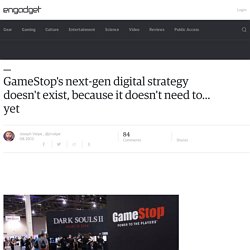
In its place are huge gains from the company's mobile and digital businesses, though it's not quite robust enough to supplant the decline in overall revenue. Holiday sales of the PlayStation 4 and Xbox One will, no doubt, provide a significant boost to GameStop's bottom line, yet that uptick should prove temporary at best. As is the case with every new console launch cycle, consumer interest will eventually hit a lull and the financial onus will fall to software sales and GameStop Mobile. "We see those fast growth businesses like mobile and digital accelerating along with the console launch, " Bartel said. "The number one thing they suffer from is awareness. "We see those fast growth businesses, like mobile and digital, accelerating along with the [next-gen] console launch. " Transporter Sync: Making the cloud personal and affordable.
Earlier this year, Erica Sadun and I tested a new idea for creating a personal cloud -- the Transporter from Connected Data.
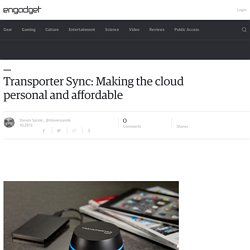
At the time, we weren't all that impressed with the device or its user interface. Our big complaint was that the software was quite confusing, requiring access to both a local app and a web interface to accomplish certain tasks. When compared to the ease of use of Dropbox, Transporter seemed like a total hassle to use. Well, Connected Data went back to the drawing board and today announced both a new device -- Transporter Sync (US$99) -- and a much more Dropbox-oriented solution to a personal cloud. The idea of Transporter is that you can create your own "cloud" by taking network-attached storage and syncing it with similar units at the office, at a relative's home, or basically anywhere else offsite.
The Transporter Sync is a tiny little device, but with the availability of inexpensive external disk drives, it can provide a mountain of storage in the cloud. BlackBerry's building software to help power self-driving cars. It's all about the flexibility, really.
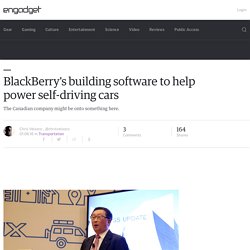
BlackBerry's approach means car makers can build features for self-driving cars on top of a common core, rather than spending years trying to build that core themselves. The framework BlackBerry has already made is surprisingly thoughtful too; the company has whipped up reference systems for "building multi-camera car vision systems" and applications that let cars communicate with each other. Self-driving cars are finally becoming a reality; Ford CEO Mark Fields said yesterday that mainstream models are about four years away.
ICYMI: The best health innovations of the year. Microsoft shows how the Internet of Things can actually be interesting. For how excited everyone at CES is about the Internet of Things, most examples of it have tended to be pretty boring.
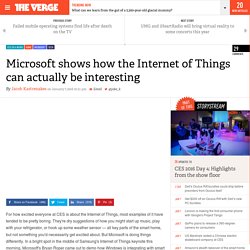
They're dry suggestions of how you might start up music, play with your refrigerator, or hook up some weather sensor — all key parts of the smart home, but not something you'd necessarily get excited about. But Microsoft is doing things differently. In a bright spot in the middle of Samsung's Internet of Things keynote this morning, Microsoft's Bryan Roper came out to demo how Windows is integrating with smart home platforms to present data about your home. Roper's enthusiasm is a huge part of what makes the demo interesting, but it also stands out because we get to see more than just a basic integration of two devices. Roper uses Cortana to generate a chart comparing people in the house and how much they use different appliances; based on what it displays, he's then able to drill down for more information. Amazon's stealth takeover of the smart home at CES 2016. Of all the forecasts made here at CES, the smart home feels like one of the nearest to coming true.

Nearly every big-name technology brand, from Google to Samsung to LG, is in the process of trying to own the way we interact with our appliances and our appliances interact with each other. But the most important name in the smart home is the one you’re least likely to find plastered inside the cavernous halls of the Las Vegas Convention Center: Alexa. The name corresponds to Amazon’s cloud-based voice assistant, which began as the personal assistant inside the online shopping company’s Echo speaker that went on sale to the public in June. Over the course of a few months, however, Alexa has moved beyond Echo and into a host of third-party devices, in part thanks to Amazon’s $100 million Alexa Fund, which helps other companies incorporate the software into their products.
At CES 2016, Alexa is weaving its way into third-party products. I just built an Audi R8 on the moon. The window for writing earnest "holy crap, VR is amazing" pieces largely closed years ago.
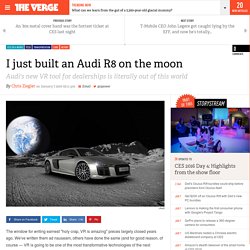
We've written them ad nauseam, others have done the same (and for good reason, of course — VR is going to be one of the most transformative technologies of the next decade). Many of these pieces are great; some come about as close to conveying the experience of putting on modern, high-resolution, low-latency VR goggles as they possibly could without physically handing you a pair of your own to try on. Now, as with drones, the conversation is shifting away from the whiz-bang of great VR hardware to applications. I just built an Audi R8 on the moon. The New York Public Library just uploaded nearly 200,000 images you can use for free. The search for the killer bot. By Casey Newton | Illustrations by Peter Steineck The first bot I ever befriended went by the name of GooglyMinotaur.
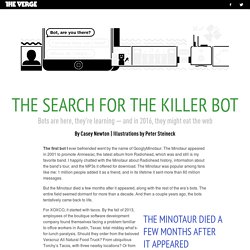
The Minotaur appeared in 2001 to promote Amnesiac, the latest album from Radiohead, which was and still is my favorite band. I happily chatted with the Minotaur about Radiohead history, information about the band’s tour, and the MP3s it offered for download. The Minotaur was popular among fans like me: 1 million people added it as a friend, and in its lifetime it sent more than 60 million messages.
But the Minotaur died a few months after it appeared, along with the rest of the era’s bots. The water bottle of the future has a built-in screen. The water bottle does work on its own, though.
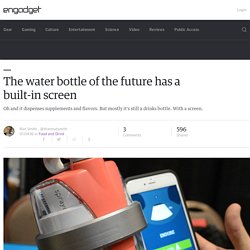
There's a smartwatch-sized display lodged in the center of the bottle, with a pair of buttons underneath to select supplements and subsequently order them into your drink. Both the screen and the motors responsible for dropping in the supplements can be recharged wirelessly, and according to a LifeFuels spokesman, this will have to be done every couple of days -- depending on how much you like to supplement your life. The company has struck deal with 40 different drinks brands: the pods will come in a range including vitamin supps as well as flavorings like coconut water. The smart bottle also pairs to health and fitness apps including FitBit, MyFitnessPal and Apple Health, sharing nutrition and water intake metrics where it can.
Owlet's smart baby monitor can save lives while looking cute. The monitor itself is a cute little cloth booty with a teensy pulse oximeter to track your baby's heart rate and measure how much oxygen is in their blood.

Introducing the Best of CES 2016 finalists! Our editors have been on the ground for the better part of this week scouring every nook and cranny in Las Vegas to bring you the latest and greatest from CES 2016.

And now we're ready to announce to you our finalists for the official Best of CES awards. Below you'll find our selections for all 14 categories, which range from best wearables to the most innovative tech we've seen at the show. We'll announce our category winners tomorrow, which is also when we'll reveal our Best of the Best award recipient, the most coveted prize of them all. That special award is selected from our pool of category winners. If you want your voice heard too -- no worries! Photo by Will Lipman. 'Our ultimate goal is to inspire tomorrow’s inventors' Take a block of plastic, some magnetic wheels and a smartphone app, and what do you get?
A moving sports car, a revolving fairground carousel or a launchable rocket, as inventor Peter Spence is happy to demonstrate. Spence is co-founder of Tio, which makes a kit to build app-controlled toys. Together, the block, wheels, app, plus a mount, give motion, power and light to whichever object they are attached to. For example, attach the kit to a car made out of Lego, or a rocket made out of an empty plastic bottle, and they are transformed into app-controlled toys. First passenger drone makes its debut at CES. A Chinese company claimed a world first on Wednesday by unveiling a drone capable of carrying a human passenger. Guangzhou-based Ehang Inc pulled the cloth off the Ehang 184 at the Las Vegas convention center during the CES gadget show.
In a company video showing the 184 flying, it looks like a small helicopter but with four propellers spinning parallel to the ground in a similar configuration to other drones. The electric-powered drone can be fully charged in two hours, carry up to 100kg (220lb) and fly for 23 minutes at sea level, according to Ehang. The cabin fits one person and a small backpack and is fitted with air conditioning and a reading light. It is designed to fit, with propellers folded, in a single parking spot.
Headset provides '3D soundscape' to help blind people navigate cities. Knobbly pavements and ticking pedestrian crossings are one thing, but the frustrating experience of getting around the city for visually impaired people could soon be revolutionised by a new navigational headset which claims to let you hear your surroundings as a “3D soundscape”. Developed by Microsoft and the Guide Dogs charity over the last two years, with the government-funded Future Cities Catapult, the headset contains a GPS tracker, compass and gyroscope, and can be programmed to talk to you through your route, like a pedestrian sat-nav.
Paired with a smartphone, it uses location information from Microsoft’s Bing maps, which can be supplemented by tiny Bluetooth-enabled beacons stuck to lamp-posts around the city. Turning sunlight into clean fuel is now cheap and simple. London's first underground farm to harvest first crop 100 feet below street level. London’s new underground farm is nearly open for business. We’ve reported on Growing Underground in the past, when the founders used crowdfunding to raise money for their equipment. This week, the city’s first subterranean farm is nearing completion of ‘phase one’ of production, putting the producers just a few weeks away from delivering the first harvest of pea shoots, radishes, and celery to commercial customers. Growing Underground is the brainchild of West Country entrepreneurs Richard Ballard and Steven Dring, in partnership with Michel Roux Jr, the Michelin-starred chef.
The farm is housed in a disused World War II tunnel under Clapham and will utilize around 2.5 acres of tunnels once the future phases of setup are complete. Glowing bandages can reduce the chances of antibiotic-resistant bugs. OpenKnit: An Open-Source "Clothing Printer" That Lets You Make Your Own Garments. There’s 3D printers for chocolate, food, jewelry, houses, plastic parts and now there is a 3D printer to knit your own clothes. The OpenKnit Printer by Gerard Rubio will let you knit your own sweater in less than an hour. Made in your own home or studio, these DIY clothes are designed with the help of Knitic software and the open source knitting platform to express yourself on the fly and on demand. Everyone can go to the store and buy a sweater, but not everyone can knit a sweater and certainly no one can knit a sweater in less than an hour. But with your very own knitting machine, you can design your own shirt, scarf, sweater, dress, whatever and then set the OpenKnit printer to work and have a completed garment in no time.
Project Sunroof. Enter your home address to analyze your roof's solar potential. Google's Project Sunroof can assess homes in more states. Automatic garbage bin promises to clean the oceans. Gogoro has a plan to quickly get scooters into your city. Introducing the world's first and only Smartscooter™ Scientists use battery tech to harvest energy from movement. Current motion electric tech, including piezoelectrics and triboelectrics, rely on mechanical means to generate power. However, the systems require high-frequency sources of motion, so they don't work well during activities like exercising. The prose at the end of the universe.
This high-end fashion brand is an experiment in treating workers fairly. About. Up School. Now we can 3D print ceramics. OMsignal's biometric sports bra hits stores this spring. MIT's 'Galileo' matches humans at predicting how things move. Delivering Medicine Through Lettuce, World Altering Medical Advancements. You can now buy a Bluetooth pregnancy test. Instead, there's a tiny screen, like the one you might find on a thermometer, that shows a symbol once you've opened it up that indicates it's ready to be paired with your iOS or Android smartphone.
But first, you'll want to download the First Response Pregnancy Pro app to your phone -- this is where everything related to the pregnancy test will happen. The app first asks you a couple easy questions: are you actively trying to get pregnant or not, and the first day of your last menstrual cycle. Researchers use 3D printer, sugar, to create a fake artery network for lab-grown tissue.
FDA approves a drug made using 3D printing. Headset provides '3D soundscape' to help blind people navigate cities. Delivery on demand: the desire for instant access anywhere. This high-end fashion brand is an experiment in treating workers fairly. 7 Digital Marketing Trends to Watch Out for 2016. Hotspots: This month’s top trend observations. Social Internet of Things: Turning Smart Objects into Social Objects to Boost the IoT - IEEE Internet of Things.
Elon Musk says he now knows when the safe, fully autonomous self-driving car will arrive. Emerging Trend: Snapchat for Brands. The online marketing trends that will rule 2016 — expert roundup — Content Marketing. 16 Web & Graphic Design Trends To Watch In 2016 — Visual Stories. 6 Interior Design Trends To Watch For 2016. Forbes Welcome. Welcome. Davide Sher's Top 2015 3D Printing Applications. Top 10 Global Future Trends 2016 - Entrepreneurs Institute. Forbes Welcome. Frog Predicts Tech Trends Of 2016. 10 Digital Trends every Digital Marketer should know about in 2016. Top 10 Payment Trends for 2016. Five payment trends for 2016. Sustainable fashion symposium 1. 3D-printed performance footwear from Adidas. Add a 3D printer to the list of things your phone can replace. Target is reportedly working on its own mobile payments, too. Apple Pay’s peer-to-peer feature might use iMessage.
A group of retailers can't support Apple Pay due to contract with rival tech. Best of both worlds: Banks attempt to combine digital and in-person advising. 10 Digital Trends every Digital Marketer should know about in 2016. Top 10 Payment Trends for 2016. I Social Media Trend da conoscere per il 2016. Etsy launches curated local shopping guides for four cities. LG's robotic vacuum is both janitor and security guard. The Most Cleverly Designed Objects of 2015. 10 Digital Trends every Digital Marketer should know about in 2016. How Meerkat Will Change the 2016 Election for Every Campaign, Reporter and Voter — Backchannel. Hotel de Rome - Luxury Hotel in Berlin - Rocco Forte. 100 User Experience Design & Evaluation Methods for Your Toolkit. Are You Ready for Pantone 2016 Color Trends? Trend Forecasting themes - Technology. Ingestible Bio-Bots Design the Healthy Body of the Future. What Technology Will Look Like In Five Years.
Anti-smartphone art needs to give us a break. 5 Trends for 2016. 5 Digital Marketing Trends in Banking for 2016. 9 developer trends you can bank on in 2016. Counter-at-hack. Untitled. Blog. Technology Archives - WGSN/INSIDER. TIME TO THINK: GLOCALISATION 2030+ ‘BETAPRENEURSHIP’ PROMOTES GROWTH - Global Influences - The Kjaer Global Blog. What’s Motivating Consumers in 2016? Consumer Trends for 2016 and Beyond! David Mattin, Head of Trends, Tr… WOMEN AND THE NEW ECONOMY 2035+ - Global Influences - The Kjaer Global Blog. GLOBAL CITIZENS AND DIGITAL CREATIVITY - Global Influences - The Kjaer Global Blog. WGSN SS15 MACRO TRENDS. Mintel predicts four consumer trends for 2016.